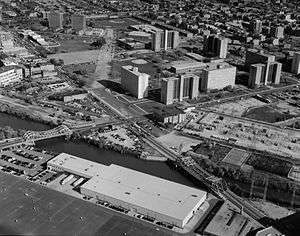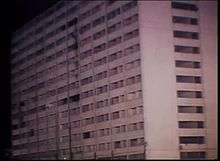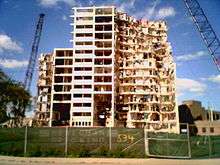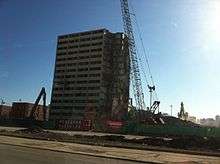Cabrini–Green Homes
| Cabrini–Green Homes | |
|---|---|
|
1999 photograph looking northeast on Cabrini–Green housing project. | |
| Location |
Bordered by the apex of Clybourn Avenue (North), Larrabee Street (East), Chicago Avenue (South), Halsted Street (West) Chicago, Illinois, |
| Coordinates | 41°54′16.13″N 87°38′43.48″W / 41.9044806°N 87.6454111°WCoordinates: 41°54′16.13″N 87°38′43.48″W / 41.9044806°N 87.6454111°W |
| Status |
586 units (Row-houses; renovated) |
| Constructed | 1942–1962 |
| Demolished |
1995–2011 (High-rises/Mid-rises) |
| Governing Body | Chicago Housing Authority |
Cabrini–Green Homes (Frances Cabrini Row-houses and William Green Homes) was a Chicago Housing Authority (CHA) public housing project located on the Near North Side of Chicago, Illinois, United States. It was bordered by the apex of Clybourn Ave and Halsted Street on the north, North Larrabee Street on the west, Chicago Avenue on the south, Hudson Street on the east. Today, only a small set of row houses, built in the 1940s, remain (south of Oak Street, north of Chicago Avenue, west of Hudson Avenue, and east of Larrabee Street).[1]
At its peak, Cabrini–Green was home to 15,000 people,[2] living in mid- and high-rise apartment buildings totaling 3,607 units. Over the years, crime, gang violence and neglect created deplorable living conditions for the residents, and "Cabrini–Green" became synonymous with the problems associated with public housing in the United States. The last of the buildings in Cabrini–Green was demolished in March 2011.[3] The Near North Side site formerly home to the William Green projects has been undergoing major redevelopment since the late 1990s, resulting in a combination of upscale high-rise buildings and row houses, with the stated goal of creating a mixed-income neighborhood, with some units still being reserved for public housing tenants. Controversy regarding the implementation of such plans has arisen (due to the crime element within remaining row houses), though slated redevelopment plans are now set to move forward following the September 2015 settlement of a longstanding civil lawsuit.[2]
Layout and demographics
The construction reflected the "urban renewal" approach to United States city planning in the mid-20th century. The extension buildings were known as the "red" for their red brick exteriors, while the Green Homes, with reinforced concrete exteriors, were known as the "whites".[1] Many of the high-rise buildings originally had exterior porches (called "open galleries"). According to the Chicago Housing Authority (CHA), the early residents of the Cabrini row houses were predominantly of Italian ancestry.[4] By 1962, however, a majority of residents in the completed complex were black.
Timeline
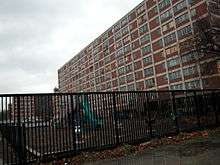
- 1850: Shanties were first built on low-lying land along Chicago River; the population was predominantly Swedish, then Irish. The area acquires the "Little Hell" nickname due to a nearby gas refinery, which produced shooting pillars of flame and various noxious fumes. By the 20th century, it was known as "Little Sicily" due to large numbers of Sicilian immigrants.[5]
- 1929: Harvey Zorbaugh writes "The Gold Coast and the Slum: A Sociological Study of Chicago's Near North Side", contrasting the widely varying social mores of the wealthy Gold Coast, the poor Little Sicily, and the transitional area in between. Marshall Field Garden Apartments, first large-scale (although funded through private charity) low-income housing development in area, completed.
- 1942: Frances Cabrini Homes (two-story rowhouses), with 586 units in 54 buildings, completed. Initial regulations stipulate 75% white and 25% black residents. Holsman, Burmeister, et al., architects. (Named for Saint Frances Cabrini, an Italian-American nun who served the poor and was the first American to be canonized.)
- 1957: Cabrini Homes Extension (red brick mid- and high-rises), with 1,925 units in 15 buildings, is completed. A. Epstein & Sons, architects.
- 1962: Green Homes (1,096 units, north of Division Street) is completed. Pace Associates, architects. (Named for William Green, longtime president of the American Federation of Labor.)
- 1966: Gautreaux et al. vs. Chicago Housing Authority, a lawsuit alleging that Chicago's public housing program was conceived and executed in a racially discriminatory manner that perpetuated racial segregation within neighborhoods, is filed. CHA was found liable in 1969, and a consent decree with HUD was entered in 1981.
- April 4–13, 1968: In the days immediately following the assassination of Dr. Martin Luther King, Jr., constant gunfire from snipers positioned on the upper floors of Cabrini–Green caused many casualties and much property damage. The sniper activity would return periodically throughout the 1970s.
- July 17, 1970: Sergeant James Severin and Officer Tony Rizzato of the Chicago Police Department are fatally shot.[6]
- February 8, 1974: Television sitcom Good Times, ostensibly set in the Cabrini–Green projects (though the projects were never actually referred to as "Cabrini-Green" on camera), and featuring shots of the complex in the opening and closing credits, debuts on CBS. It would run for six seasons, until August 1, 1979.
- March 26 – April 19, 1981: Mayor Jane Byrne moves into Cabrini–Green to prove a point regarding Chicago's high crime rate. Considered a publicity stunt,[7] she stays just three weeks.
- October 13, 1992: Dantrell Davis was holding his mother's hand on his way to school, when he was fatally shot by a stray bullet.[8]
- 1992: Candyman is released, the story taking place at the housing project.
- 1994: Chicago receives one of the first HOPE VI (Housing Opportunities for People Everywhere) grants to redevelop Cabrini–Green as a mixed-income neighborhood.[9]
- September 27, 1995: Demolition begins.[10]
- January 9, 1997: Nine-year-old "Girl X" (since identified as Shatoya Currie[11]) found in a seventh-floor stairwell at 1121 N. Larrabee Street after being raped, beaten, choked, poisoned by having a can of insecticide sprayed down her throat, and covered in gang symbols. Her attacker then stepped on her throat. She was left for dead. Ultimately, the attacker was identified as Patrick Sykes and was found with the assistance of community members and building gang members, all of whom were outraged by the attack. Sykes had a history of sexual crimes against women and girls, and admitted he covered Currie with gang symbols in an attempt to confuse investigators. Currie survived, but was blinded and left with significant brain damage. During her hospitalization, Nation of Islam leader Louis Farrakhan visited and prayed at her bedside.[12]
- 1997: Chicago unveils Near North Redevelopment Initiative, a master plan for development in the area. It recommends demolishing Green Homes and most of Cabrini Extension.[5]
- 1999: Chicago Housing Authority announces Plan for Transformation,[5] which will spend $1.5 billion over ten years to demolish 18,000 apartments and build and/or rehabilitate 25,000 apartments. Earlier redevelopment plans for Cabrini–Green are included in the Plan for Transformation. New library, rehabilitated Seward Park, and new shopping center open.
- December 9, 2010: The William Green Homes complex's last standing building closes.[13]
- March 30, 2011: the last high-rise building was demolished, with a public art presentation commemorating the event.[14] The majority of abandoned and rundown Frances Cabrini Homes row houses remain intact and a hot bed for crime in the area.
History
Cabrini–Green was composed of 10 sections built over a 20-year period: the Frances Cabrini Rowhouses (586 units in 1942), Cabrini Extension North and Cabrini Extension South (1,925 units in 1957), and the William Green Homes (1,096 units in 1962) (see Chronology below). As of May 3, 2011, all high-rise buildings have been demolished. The dilapidated Frances Cabrini Rowhomes (south of Oak Street, north of Chicago Avenue, west of Hudson Avenue, and east of Cambridge Street) remain inhabited.
Problems develop
Poverty and organized crime have long been associated with the area: a 1931 "map of Chicago's gangland" by Bruce-Roberts, Incorporated, notes Locust and Sedgwick as "Death Corner": "50 murders: count 'em".[15] At first, the housing was integrated and many residents held jobs. This changed in the years after World War II, when the nearby factories that provided the neighborhood's economic base closed and thousands were laid off. At the same time, the cash-strapped city began withdrawing crucial services[1] like police patrols, transit services, and routine building maintenance. Lawns were paved over to save on maintenance, failed lights were left for months, and apartments damaged by fire were simply boarded up instead of rehabilitated and reoccupied. Later phases of public housing development (such as the Green Homes, the newest of the Cabrini–Green buildings) were built on extremely tight budgets and suffered from maintenance problems due to the low quality of construction.
Unlike many of the city's other public housing projects such as Rockwell Gardens or Robert Taylor Homes, Cabrini–Green was situated in an affluent part of the city. The poverty-stricken projects were actually constructed at the meeting point of Chicago's two wealthiest neighborhoods, Lincoln Park and the Gold Coast. Less than a mile to the east sat Michigan Avenue with its high-end shopping and expensive housing. Specific gangs "controlled" individual buildings, and residents felt pressure to ally with those gangs in order to protect themselves from escalating violence.
During the worst years of Cabrini–Green's problems, vandalism increased substantially. Gang members and miscreants covered interior walls with graffiti and damaged doors, windows, and elevators. Rat and cockroach infestations were commonplace, rotting garbage stacked up in clogged trash chutes (it once piled up to the 15th floor), and basic utilities (water, electricity, etc.) often malfunctioned and were left unrepaired. On the exterior, boarded-up windows, burned-out areas of the façade, and pavement instead of green space—all in the name of economizing on maintenance—created an atmosphere of decay and government neglect. The balconies were fenced in to prevent residents from emptying garbage cans into the yard, and from falling or being thrown to their deaths. This created the appearance of a large prison tier, or of animal cages, which further enraged community leaders of the residents.[16]
Brother Bill
Since the 1980s, a Catholic lay worker, William "Brother Bill" Tomes, Jr. frequently visited Cabrini–Green in an effort to stop the violence. His efforts received national attention and he was interviewed by Time magazine and several television networks.[17]
Tenant activism
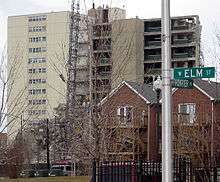
In response to the various problems associated with living in Cabrini–Green, residents organized over the years both to pressure the city for assistance and to protect and support each other. Community leader Marion Stamps was the most visible Cabrini tenant to organize strikes and protests against the Chicago Housing Authority, Mayor of Chicago and many others on behalf of Cabrini residents from the 1960s until her death in 1996. In 1996, the federal government mandated the destruction of 18,000 units of public housing in Chicago (along with tens of thousands of other units nationwide).[1]
In response, some Cabrini–Green tenant activists organized to prevent themselves from becoming homeless and to protect what they and their supporters see as a right to public housing for the city's poorest residents. The activists succeeded in obtaining a consent decree guaranteeing that some buildings will remain standing while the new structures are built, so that tenants can remain in their homes until new ones are available.[18] The document also guarantees displaced Cabrini residents a home in the new neighborhood. In 2001, a tenants group sued the CHA over relocation plans[1] for displaced residents of Cabrini–Green under the city's Plan for Transformation, a $1.4 billion blueprint for public housing renewal. Richard Wheelock, an attorney representing the tenants, said the authority's demolition program had outpaced its reconstruction program, thus leaving families with their own responsibilities to find options beyond equally dangerous and segregated areas elsewhere in the city, or simply becoming homeless.
Recent history and future plans
While Cabrini–Green was deteriorating during the postwar era, causing industry, investment, and residents to abandon its immediate surroundings, the rest of Chicago's Near North Side underwent equally dramatic upward changes in socioeconomic status. First, downtown employment shifted dramatically from manufacturing to professional services, spurring increased demand for middle-income housing; the resulting gentrification spread north along the lakefront from the Gold Coast, then pushed west and eventually crossed the river. Then, in the 1980s, the Lower North Side industrial area (just across the river from the Loop, west of Michigan Avenue, and south of Near North Side's Cabrini–Green) was transformed into the "River North" neighborhood, a focus of arts and entertainment, now home to the city's technology sector. By the 1990s, developers had converted thousands of acres of former industrial lands near the north branch of the Chicago River (and directly north, south, and west of the former Cabrini–Green projects) to lucrative office, retail, and housing developments.
Over time, Cabrini–Green's location became increasingly desirable to private developers. Speculators began purchasing property immediately adjacent to the projects, with the expectation that the complex would eventually be demolished. Finally, in May 1995, the federal Department of Housing and Urban Development (HUD) took over management of the CHA and almost immediately began demolishing the first of the vacant "reds" buildings in Cabrini Extension, intending to make Chicago a showpiece of a new, mixed-income approach to public housing. Shortly thereafter, in June 1996, the city of Chicago and the CHA unveiled the Near North Redevelopment Initiative, which called for new development on and around the Cabrini–Green site. Under a ten-year Plan for Transformation, which was officially enacted in 2000, the city plans to demolish almost all of its high-rise public housing, including much of Cabrini–Green (except for a few of the run down row houses, which tentatively remain).[19]
Demolition of Cabrini Extension was completed in 2002; part of the site was added to Seward Park, and construction of new, mixed-income housing on the remainder of the site began in 2006. Subsidized development of mixed-income housing on vacant or underused parcels adjacent to Cabrini–Green, including a long-shuttered Oscar Mayer sausage factory, the former headquarters of Montgomery Ward, and an adjacent senior housing project named Orchard Park, began in 1994. New market-rate housing now almost completely surrounds the remaining public housing. Cabrini–Green once housed 15,000 residents. New housing built on the 70-acre (280,000 m2) Cabrini–Green site will include 30% public-housing replacement homes and 20% "workforce affordable" housing, while many adjacent developments (almost all targeted at luxury buyers) include 20% affordable housing, half targeted as public-housing replacement, with a goal of 505 replacement units built off-site.
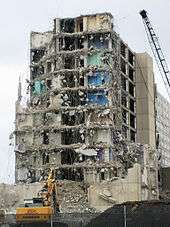
In February 2006, a unique partnership between CHA, Holsten, Kimball Hill Urban Centers and the Cabrini–Green LAC Community Development Corporation began a 790-unit, $250-million redevelopment of the 18-acre (73,000 m2) Cabrini Extension site, to be called Parkside at Old Town. Plans completed the demolition of Green Homes in 2011, while the majority of Cabrini's dilapidated row houses are abandoned and slated for demolition and future redevelopment. The Plan for Transformation's relocation process was the subject of a lawsuit, Wallace v. Chicago Housing Authority, which alleged that many residents were hastily forced into substandard, "temporary" housing in other slums, did not receive promised social services during or after the move, and were often denied the promised opportunity to return to the redeveloped sites.[20] The lawsuit was settled in June 2006, as the parties agreed to two relocation programs for current and former CHA residents: (1) CHA's current relocation program, encouraging moves to racially integrated areas of metropolitan Chicago and providing for case-managed social services, would be applied to families initially moving from public housing; and (2) an agreed-upon modified program run by CHA's voucher administrator, CHAC Inc., would encourage former CHA residents to relocate to economically and racially integrated communities as well as give them increased access to social services.[21]
Some former CHA residents have moved out of Chicago to nearby south suburbs such as Harvey or to other housing developments in nearby cities. New residents have successfully moved into CHA replacement housing, and to date, residents of the mixed-income developments have reported fewer crime related problems. The last two families in Cabrini–Green were forced out by a federal judge's decree on December 1, 2010.[22] Crime has dramatically decreased as the area's population has shifted; in the first half of 2006, only one murder occurred. Demolition of Cabrini–Green continued slowly and was completed in 2011. Plaintiffs in Wallace and others allege that CHA's hasty removal of residents has exacerbated socioeconomic and racial segregation, homelessness, and other social ills that the Plan for Transformation aimed to address by forcing residents to less-visible but still impoverished neighborhoods, largely on the south and west sides of the city.[23][24][25] Retail chain Target has built on the site at Division and Larrabee Streets, formerly occupied by 1230 N. Larrabee and 624 W. Division high-rises of the Green Homes. The new address is at 1200 N. Larrabee, and it opened to the public in October 2013.[26]
Reputation
Though Chicago has had a number of notorious public housing projects, including the Robert Taylor Homes and Stateway Gardens on the South Side, and Rockwell Gardens and the Henry Horner Homes on the West Side, Cabrini–Green's name and its problems were the most publicized, especially beyond Chicago. Cabrini–Green often gained press coverage for its chaotic New Year's Eve celebrations when gang members fired guns into the air causing police to block off nearby streets every year. Several infamous incidents contributed to Cabrini–Green's reputation.
An unanticipated result of the steel fencing installed to secure the previously open gangways at Cabrini–Green was that it became difficult for Chicago police officers to see through the steel mesh from outside. On July 17, 1970,[27] Chicago police patrolman Anthony N. Rizzato and Sergeant James Severin were shot and killed by gang members while patrolling community housing for an all-volunteer "Walk and Talk" project. As the officers proceeded across the Cabrini–Green baseball field, the assailants opened fire from an apartment window. The purpose of the shooting was to seal a pact between two rival gangs. Both officers were killed in the attack. Three adults and one juvenile were later charged with murder. The two shooters were sentenced to 100–199 years in prison for two counts of murder.[28] In 1981, the gang killings of 11 made national attention.[29]
In March 1981, as an effort to demonstrate a commitment to making the complex safer, then-Chicago Mayor Jane Byrne moved into a fourth-floor apartment in the 1160 N. Sedgwick building with her husband.[29][30] Backed by a number of police officers and a substantial personal bodyguard presence, she stayed for only three weeks, and this incident contributed to public perception of Cabrini–Green as the worst of the worst of public housing. As a security measure, the rear entryway of the unit Byrne stayed in was welded shut. This had the impact of creating a fortification for gang members when Byrne left. Many other gangs copied this technique in other units.
On October 13, 1992, seven-year-old Dantrell Davis was shot in the head and killed by a sniper's stray bullet while walking to Jenner Elementary School with his mother. On January 9, 1997, nine-year-old "Girl X" (since identified as Shatoya Currie[11]) was raped and poisoned in a stairwell of the 1120 N. Larrabee building, leaving her blind, paralyzed and mute.[31][32] The Gangster Disciples, the primary gang in Cabrini, were so incensed that their letters were scrawled on the girl's stomach that they ordered members to find the attacker, police said.[33] The attacker, 25-year old Patrick Sykes (who was not a gang member), was later apprehended by police and sentenced to 120 years in prison.[34][35] While many nonresidents regarded Cabrini–Green with almost unalloyed horror, long-term residents interviewed by a Chicago Tribune reporter in 2004 described mixed feelings about the end of the Cabrini–Green era.[36] They told the reporter that, in the face of their hardships living in such squalor, many residents had developed bonds of community and mutual support. They lamented the uprooting and scattering of that community, and worried about what would become of the residents who were being relocated out of the crime prone, rundown projects to make way for much needed urban redevelopment.
Education
Most of the Cabrini–Green teenagers attend William H. Wells High School. Waller High School (now known as Lincoln Park High School), operated by Chicago Public Schools, also serves area students. Near North Career Metropolitan High School, located at Larrabee and Sedgwick, evolved from Cooley Vocational High School and served area students from 1979 until 2001.
At Cabrini–Green's height when over 15,000 residents lived in the neighborhood, there were five neighborhood elementary schools operated by Chicago Public Schools serving the neighborhood: Richard E. Byrd Community Academy, Jenner Academy of the Arts, Manierre School, Schiller Community Academy, and Truth School. As of 2008, only three of the schools remain in use.
During the 2003–2004 school year, fifth-grade students from Room 405 at Richard E. Byrd Community Academy developed a comprehensive action plan to push the City of Chicago and the Chicago Board of Education to fulfill an old promise of building a new school for the community. They cited that their school had no lunchroom, no gym, and no auditorium. The heat often did not work and students were forced to wear hats, gloves, and coats in the classroom, among many other inadequacies. As they researched reasons for the decrepit and shameful conditions of their school, they examined issues related to equity in school funding. To further their cause and implement their plan, the young activists wrote letters and emails, surveyed, petitioned, interviewed legislators, developed and produced a DVD, video documentaries, and a website in an effort to "get the word out" and garner support in hopes of seeing the new school built. Their fight for the new building garnered local and national attention.[37] As of 2008, the school's students have transferred to other schools in the Chicago area and the school has been left vacant.
In popular culture
- Comics
- The Frank Miller-created comics heroine Martha Washington is born in a dystopian alternate-universe version of Cabrini–Green that has been physically walled off from the rest of Chicago. Her father is killed by police in a demonstration protesting the prison-like conditions. Eventually, Martha appeals to a liberal president, who orders the enclosing structure to be torn down.
- Film
- The opening shot and many scenes in Cooley High (1975) take place at the Cabrini–Green Homes, and the film portrays the lives of young people in those projects. The film's creator, Eric Monte, was raised at Cabrini–Green Homes and attended the real-life Cooley Vocational High School.[38]
- The 1992 film Heaven is a Playground covers the story of a basketball coach running a player farming system in a Cabrini–Green playground
- In the horror film Candyman (1992), Cabrini–Green appears as the focal point of the titular character's supernatural activity.[39]
- The 1999 film Whiteboyz centers around the main characters trip from the middle of Iowa to Cabrini–Green to experience the gang lifestyle.
- The 2001 movie Hardball was flimed there.
- The documentary 70 Acres in Chicago, about Cabrini–Green by Ronit Bezalel, who spent two decades there beginning in 1995 was screened at the Gene Siskel Film Center in 2015.[40]
- Games
- In the video game Watch Dogs (2014), Cabrini–Green (along with Robert Taylor Homes) are represented by the Rossi-Fremont housing development which are featured in multiple missions.
- Television
- The final days of the Cabrini–Green Homes are featured in episode 4 of The Chicago Code titled "Cabrini–Green".
- In the Starz television series Boss, Cabrini–Green serves as the inspiration and filming location for the "Lennox Gardens" housing project.[41][42]
- Cabrini–Green is implicitly the home of the Evans family in the television series Good Times. Though the family was never specifically stated as living there onscreen, the project was seen in the show's opening credits.
- The PJs, an American stop-motion animated television series, portrays life in an urban public housing project, modeled after Cabrini–Green.
See also
- Edifício São Vito, a similarly problematic building in São Paulo City, Brazil
- Frances Xavier Cabrini
- Robert Taylor Homes, Chicago
- Pruitt–Igoe, St. Louis, Missouri
- List of public housing developments in the United States
References
- 1 2 3 4 5 Ihejirika, Maudlyne (October 23, 2010). "Cabrini-Green's last stand: Families prepare to move out". Chicago Sun-Times. Retrieved July 11, 2014.
- 1 2 Saulny, Susan (March 18, 2007). "At Housing Project, Both Fear and Renewal". The New York Times. New York: NYTC. ISSN 0362-4331. Retrieved July 11, 2014.
- ↑ Guzzardi, Will (March 30, 2011). "Cabrini-Green Demolition: Last Building Coming Down Wednesday (VIDEO)". Huffington Post.
- ↑ Chicago Housing Authority website "History"
- 1 2 3 Payton (January 2, 2003). "Short history of Cabrini-Green". West North. Retrieved July 11, 2014.
- ↑ Schmich, Mary (March 19, 2000). "30 Years After 2 Cops Killed, A Bid To Remember". Chicago Tribune., Retrieved 2013-05-28.
- ↑ Mayor Byrne moves into Cabrini-Green – 1981
- ↑ Kirby, Joseph A. (October 13, 1992). "The death of Dantrell Davis". Chicago Tribune., Retrieved 2013-05-28
- ↑ Smith, Janet L. (April 19, 2002). "HOPE VI and the New Urbanism: Eliminating Low-Income Housing to Make Mixed-Income Communities"., Retrieved 2013-05-28.
- ↑ McRoberts, Flynn (September 27, 1995). "Demolition Is Finally Set At Cabrini-green". Chicago Tribune., Retrieved 2013-05-28.
- 1 2 Schlesinger, Regine (24 July 2012). "Jennifer Hudson Befriends Woman Once Known as 'Girl X'". CBS Chicago. Chicago, Illinois. Retrieved 3 June 2014.
- ↑ Ex-convict charged in sexual assault of 'Girl X'
- ↑ Ihejirika, Maudlyne (9 December 2010). "Last Cabrini–Green residents prepare for move, pack up". Chicago Sun-Times. Retrieved 9 December 2010.
- ↑ Project Cabrini Green
- ↑ "Map of Chicago's Gangland, 1931". Encyclopedia of Chicago. 2009. Retrieved July 11, 2014.
- ↑ Gottfried, Keith E. (September 21, 2006). "Remarks of the Honorable Keith E. Gottfried, General Counsel of the U.S. Department of Housing and Urban Development" (PDF). Presentation at the Multi-Housing World Conference and Expo. p. 3.
- ↑ Stodghill, Ron (April 20, 1998). "In The Line Of Fire". TIME. Retrieved July 11, 2014.
- ↑ Schmich, Mary (July 9, 2004). "Buildings stand because a leader stood her ground". Chicago Tribune Web Edition.
- ↑ Chicago Housing Authority website "The CHA's Plan For Transformation"
- ↑ Business and Professional People for the Public Interest website. "Public Housing Transformation: Physical Planning, Relocation, Social Services, and Mobility Counseling Families Left Behind"
- ↑ National Center on Poverty Law. Poverty Law Library. "Wallace v. Chicago Housing Authority: Chicago Housing Authority and Housing Advocates Settle Lawsuit over Resident Relocation"
- ↑ Hawkins, Karen. Associated Press. "Chicago closes Cabrini-Green projects", December 2, 2010 edition of USA Today, National, A2. – "With the last high-rise slated for demolition in January or February, a federal judge on Wednesday[December 1] gave the last two families 10 days to move out."
- ↑ Austen, Ben (May 2012). "The last tower: The decline and fall of public housing". Harper's Magazine. Retrieved June 6, 2012.
- ↑ Rainey, Amy; Woodward, Whitney (July 1, 2005). "Rapid change: teardowns bring new residents to once-unappealing areas". The Chicago Reporter.
- ↑ Sink, Todd; Ceh, Brian (January 2011). "Relocation of urban poor in Chicago: HOPE VI policy outcomes". Geoforum. 42 (1): 71–82. doi:10.1016/j.geoforum.2010.10.001. ISSN 0016-7185.
- ↑ Mayor's Press Office (October 18, 2012). "New Target Store Coming to Near North Side". City of Chicago.
- ↑ Officer Down memeorial Page: Anthony N. Rizzato
- ↑ "Patrolman Anthony N. Rizzato, Chicago Police Department, Illinois". Officer Down Memorial Page. 2014. Retrieved July 11, 2014.
- 1 2 Hawkins, Karen. Associated Press. "Chicago closes Cabrini-Green projects", December 2, 2010, edition of USA Today, National, A2.
- ↑ Jane Byrne Cabrini-Green Easter: A Look Back At A Mayor's 1981 PR Fail That Ended In Shame
- ↑ "Media Advisories". Chicago-Kent College of Law. February 28, 2005.
- ↑ Sneed, Michael (July 23, 2012). "Aurora alleged gunman James Eagan Holmes was found with Vicodin when arrested". Chicago Sun Times. Sun Times Network. Retrieved November 6, 2014.
- ↑ Glanton, Dahleen (April 6, 1997). "The Tragic World Of Girl X". Chicago Tribune. Retrieved November 6, 2014.
- ↑ THE PEOPLE OF THE STATE OF ILLINOIS vs PATRICK SYKES Circuit Court of Cook County case No. 1-01-2942. June 30, 2003.
- ↑ U.S. News Story Page. "Bail set at $6 million for alleged assailant of Girl X" CNN interactive April 5, 1997
- ↑ Schmich, Mary. "Future closes in on Cabrini" Chicago Tribune Web Edition July 4, 2004
- ↑ Schultz, B.D. (2008). Spectacular Things Happen Along the Way: Lessons from an Urban Classroom. New York: Teachers College Press.http://store.tcpress.com/0807748579.shtml
- ↑ John, Derek (June 25, 2015). "Classic Of Black Cinema, 'Cooley High,' Celebrates 40th Anniversary". NPR.
- ↑ "Candyman (1992) – Trivia". IMDb. 2014. Retrieved July 11, 2014.
- ↑ Schmich, Mary (August 16, 2015). "A lens into Cabrini-Green's past". Chicago Tribune. Section 1. p. 3.
- ↑ "Windy-City Woman — Sanaa Lathan on Her Good-Girl Role Opposite Chicago's Bad-Boy 'Boss'". The Daily. August 18, 2012.
- ↑ "'Boss' Takes On Public Housing, Sex and Politics in Second Season". ThinkProgress. August 17, 2012.
Further reading
- Ambrose-Van Lee, Doreen. Diary of a MidWestern Getto Gurl. PublishAmerica. ISBN 1-4241-4676-3. Memoir of a childhood at Cabrini–Green.
- Ambrose-Van Lee, Doreen. Raised in Da Sun: A Gettogurl's Story. PublishAmerica. ISBN 1-4241-2315-1. Poetry by a former resident of Cabrini–Green.
- Cabrini–Green in Words and Pictures (2000). ISBN 0-942986-80-6.
- Dizikes, Peter, "Chicago hope: Ambitious attempt to help the city’s poor by moving them out of troubled housing projects is having mixed results, MIT study finds", MIT News, MIT News Office, March 3, 2011.
- "Cross The Bridge" by author and Cabrini resident Pete (K-SO G) Keller.
- The Paw Print. Walter Payton H.S., February 2009. Special Issue on Cabrini–Green.
- "Gang Leader For A Day" By Sudhir Venkatesh
External links
| Wikimedia Commons has media related to Cabrini-Green. |
- Residents' Journal—written, produced & distributed by Chicago Public Housing residents; archives contain many articles on activism at Cabrini–Green, particularly around the plans for redevelopment
- Chicago Coalition to Protect Public Housing
- Photos, Paintings and Discussions about Cabrini–Green
- Voices of Cabrini—Documentary film by Ronit Bezalel
- Mixing it Up (New title: 70 Acres in Chicago) — a film by Ronit Bezalel and a follow up to Voices of Cabrini. Still in production
- Frances Cabrini Rowhouses 2010–2013 Photography by Satoki Nagata
- CBS News: Tearing Down Cabrini–Green
- Chicago Tribune: Cabrini–Green Columns
- North Town Park site plan (redevelopment of Cabrini Extension site)
- The Encyclopedia of Chicago has very detailed background information on the history of public housing and the Near North neighborhood:
